|
Please note that 49-PET-067 is NOT the same site that was damaged in July, 2005, by construction of the new ferry terminal in Coffman Cove. That site is named, the "Coffman Cove Ferry Terminal Site," and is designated 49-PET-556. |
49-PET-067
Peter M. Bowers and Douglas R. Reger, Northern Land Use Researrch, Inc. |
|
For more information, please see the Forest Service website: http://www.fs.fed.us/r10/tongass/forest_facts/faqs/coffman.shtml |
July 2006 Update - Fieldwork took place from June 19 and July 4, 2006. We opened up over 21 square meters in three portions of the site. Over 130 visitors to site 49-PET-067 enjoyed tours by Terry Fifield, Mark McCallum, and other Forest Service Archaeologists. Archaeologists made two public presentations in the City of Coffman Cove on June 22 and June 29. Over 20 volunteers contributed to the project. Special thanks are due Terry Fifield and the Tongass National Forest, the Southeast Island School District, and the City of Coffman Cove for invaluable logistical support. For more information call Terry Fifield (907) 826-1642 or write him at tfifield@fs.fed.us. Coffman Cove is located on northeast Prince of Wales Island along Kashevarof Passage in southeast Alaska. Early in the 20th century, the Tlingit residents of the area left for larger settlements at Wrangell, Ketchikan, and other Southeast Alaskan towns. Today, about 225 people live in town. A non-Native logging camp was set up in the 1950s, and through timber harvest, road-building, and other construction during the 1960s, human burials were discovered, indicating the presence of an archaeological site. Site 49-PET-067, located in "downtown" Coffman Cove, was first excavated by the USDA Forest Service in the 1970s. The site contains a record of over 4000 years of Alaska Native occupation. In 1989, Coffman Cove was incorporated as a city, and through the State of Alaska's land selection process, the City eventually acquired former Forest Service property. The logging industry has suffered a decline, and Ketchikan Pulp Company's mill has been closed for several years. The City of Coffman Cove is searching for ways to diversify its economy, and this is one area where archaeology has an important role to play. Over the last 50 years, the Tlingit settlement remains at 49-PET-067 have suffered from on-going attrition through land and resource development. Parts of the site have been entirely lost. While the City of Coffman Cove is promoting development, the townspeople recognize they are sitting on an invaluable archaeological archive. In 1993, the Alaska State Office of History and Archaeology conducted investigations at the site to make recommendations for future management (Reger 1995). While the City now owns a portion of their downtown area, they want to gain control of another parcel on which 49-PET-067 lies. The State of Alaska has required the City to sponsor archaeological investigations prior to acquiring the land. In 1998, at the request of Forest Service archaeologist Terry Fifield, Moss inspected the archaeological site, met with the Coffman Cove City Council, and consulted with the Tlingit tribal council in Wrangell to see if a community archaeology project was feasible. Tlingit representatives have had serious concerns about the on-going damage done to a site where their ancestors lived and are buried. Only in 2005, however, did funds become available for the project. In September, 2005, the USDA Forest Service Alaska Region awarded a contract to Northern Land Use Research, Inc., for data recovery. Northern Land Use Research, Inc., is a Fairbanks-based cultural resource management firm (see www.northernlanduse.com.) Although portions of the site have been destroyed and others damaged, a great deal of archaeological material remains intact. Because the City wants to develop the land, data recovery began during the summer of 2006. Peter Bowers, Madonna Moss, and Douglas Reger are co-Principal Investigators of the project, and Terry Fifield, USDA Forest Service, is in charge of tribal consultation. The Coffman Cove project as a collaboration between various communities, involving archaeologists, the Forest Service, the City of Coffman Cove, the State of Alaska, and local communities. The information we gain will be important to understanding the archaeology of Southeast Alaska, and we hope that project results will eventually support the development of interpretive exhibits at Coffman Cove and perhaps also at the Wrangell Museum. The data generated can contribute to the expansion of the curriculum of local schools by filling in some of the details of ancient Tlingit history. We look forward to continuing to build a collaborative partnership in community archaeology at Coffman Cove. |
